(完整版)新视野大学英语读写教程第三版第一册教案
- 格式:doc
- 大小:244.04 KB
- 文档页数:48
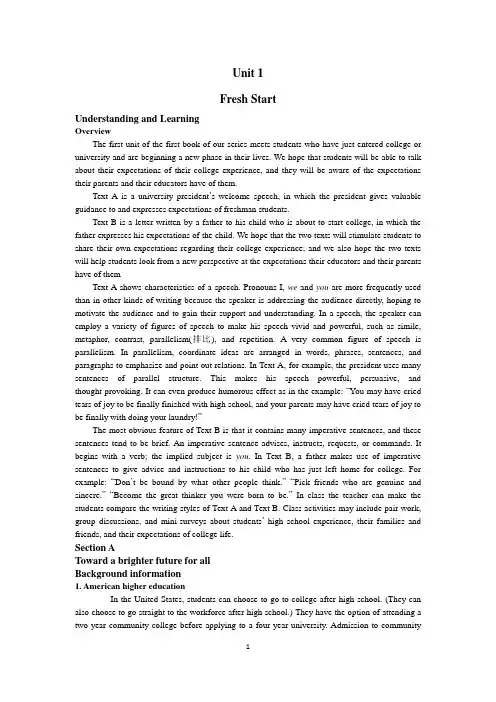
Unit 1Fresh StartUnderstanding and LearningOverviewThe first unit of the first book of our series meets students who have just entered college or university and are beginning a new phase in their lives. We hope that students will be able to talk about their expectations of their college experience, and they will be aware of the expectations their parents and their educators have of them.Text A is a university president’s welcome speech, in which the president gives valuable guidance to and expresses expectations of freshman students.Text B is a letter written by a father to his child who is about to start college, in which the father expresses his expectations of the child. We hope that the two texts will stimulate students to share their own expectations regarding their college experience; and we also hope the two texts will help students look from a new perspective at the expectations their educators and their parents have of themText A shows characteristics of a speech. Pronouns I, we and you are more frequently used than in other kinds of writing because the speaker is addressing the audience directly, hoping to motivate the audience and to gain their support and understanding. In a speech, the speaker can employ a variety of figures of speech to make his speech vivid and powerful, such as simile, metaphor, contrast, parallelism(排比), and repetition. A very common figure of speech is parallelism. In parallelism, coordinate ideas are arranged in words, phrases, sentences, and paragraphs to emphasize and point out relations. In Text A, for example, the president uses many sentences of parallel structure. This makes his speech powerful, persuasive, and thought-provoking. It can even produce humorous effect as in the example: ―You may have cried tears of joy to be finally finished with high school, and your parents may have cried tears of joy to be finally with doing your laundry!‖The most obvious feature of Text B is that it contains many imperative sentences, and these sentences tend to be brief. An imperative sentence advises, instructs, requests, or commands. It begins with a verb; the implied subject is you.In Text B, a father makes use of imperative sentences to give advice and instructions to his child who has just left home for college. For example: ―Don’t be bound by what other people think.‖―Pick friends who are genuine and sincere.‖―Become the great thinker you were born to be.‖In class the teacher can make the students compare the writing styles of Text A and Text B. Class activities may include pair work, group discussions, and mini-surveys about students’high school experience, their families and friends, and their expectations of college life.Section AToward a brighter future for allBackground information1. American higher educationIn the United States, students can choose to go to college after high school. (They can also choose to go straight to the workforce after high school.) They have the option of attending a two-year community college before applying to a four-year university. Admission to communitycollege is easier, tuition is lower, and class sizes are often smaller than at a university. Community college students can earn an associate agree and transfer up to two years of course credits to a university.College and university students need to pay tuition, but many earn scholarships or receive loans. Although admissions policies vary from one university to another, most determine admission based on several criteria, including a student’s high school course of study, high school Grade Point Average (GPA), participation in extracurricular activities, SAT(Scholastic Assessment Test) or ACT (American College Testing) exam scores, a written essay, and possibly a personal interview with a representative from the admissions office.Most students in the United States take the SAT Reasoning Test or the ACT during their final year of high school. Each university sets a minimum SAT or ACT score that a student must achieve in order to gain admission. These are standardized quantitative examinations. The SAT tests critical reading, mathematics, and writing skills, The ACT tests English, mathematics, reading, science reasoning, and includes an optional writing test.Extracurricular activities may include scholastic clubs, athletic teams, student government, and philanthropic clubs. V oluntary participation in these kinds of activities is an indication that a student has learned valuable life lessons, such as teamwork, leadership, or civic responsibility.University students pursuing a bachelor’s degree are called ―undergraduates‖; students pursuing a master’s or doctoral degree are called ―graduate students‖. Most universities give under graduate students a liberal education, which means students are required to take courses across several disciplines before they specialize in a major field of study. Graduate and professional programs, such as medicine or law, are specialized. All degree programs require students to complete a minimum number of credit hours before graduating.Selection for admission to a graduate program is based on several criteria. These include completion of a bachelor’s degree, the student’s undergraduate coursework and GPA. Students are also expected to write an essay as part of their application or to submit a writing sample. Most master’s programs require students to have a minimum score on the Graduate Record Examination (GRE), which tests verbal reasoning, quantitative reasoning, critical thinking, and analytical writing skills.Students continue to take course at the graduate level. A final thesis is required for most master’s programs. Doctoral students take course until they have earned enough credit hours to attempt their qualifying examinations. These are usually taken over several days and often include a written and oral component. After doctoral students pass their qualifying exams, they are advanced to candidacy and can begin writing their dissertation. Before the degree is given, the completed dissertation must be orally defended before the candidate’s faculty committee.2. Vera WangVera Wang is a Chinese-American fashion designer. She was born and raised in New York City. While trained as a figure skater in high school, she eventually earned a degree in art history from Sarah Lawrence College in 1971. But a career in fashion was her dream. She worked as a senior fashion editor for Vogue magazine for 15 years. In 1985, she left vogue and joined Ralph Lauren as a design director for two years. In 1990, she opened her own design salon in New York, and featured her trademark bridal gowns. Wang has made wedding gowns for many celebrities and public figures, such as Jennifer Lopez (詹尼佛·洛佩兹), Sharon Stone (莎朗·斯通) and Chelsea Clinton (切尔西·克林顿).Detailed study of the text1. Your achievement is the triumph of years of hard work, both of your own and of your parents and teachers. (Para. 1)Meaning: Your entering this university is an important success. This success is due to many years of your hard work, and many years of your parents’ and teachers’ hard work.★triumph: n. [C] an important victory or success after a difficult struggle (尤指苦战后获得的)胜利,成功,成就Winning the championship was a great personal triumph for this young tennis player.赢得冠军对这个年轻的网球运动员来说是很大的个人成就。
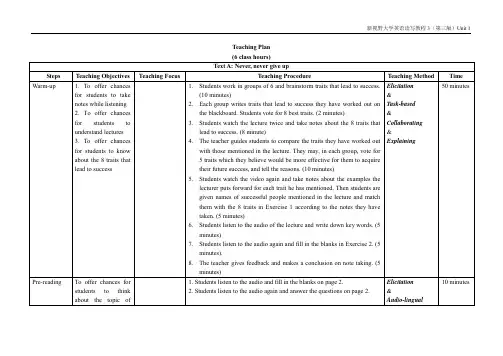
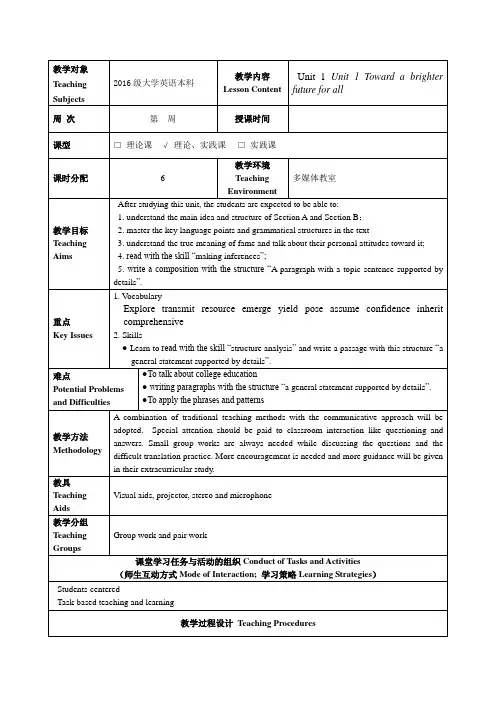
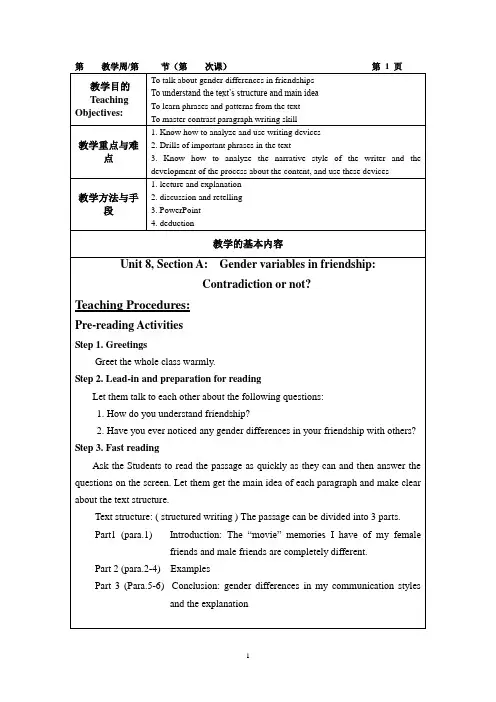
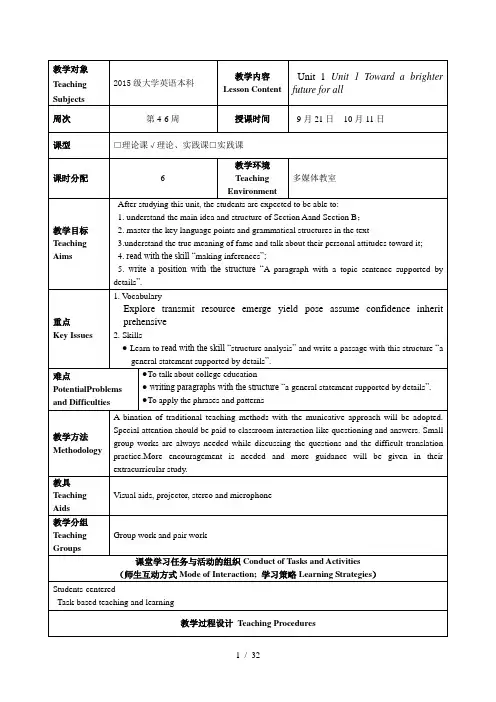

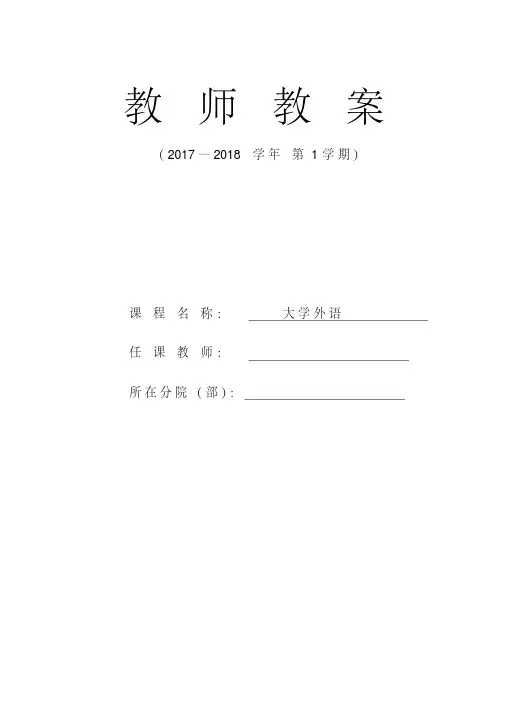
教师教案(2017—2018 学年第1学期)课程名称:大学外语任课教师:所在分院(部):Unit 1, Book OneSection A: Toward a brighter future for all Teaching Objectives:To know the meaning and usage of some important words, phrases and patterns To study Passage A and understand the main idea of the textTo understand the structure of the text and the devices for developing itTo talk about college educationTeaching Procedures:Pre-reading ActivitiesStep 1. GreetingsGreet the whole class warmly.Step 2. Lead-in and preparation for readingLet them talk to each other about the following questions:1. What is the ideal university like in your eyes?2. What are your expectations of your college life?3. What advice did your parents give you before you left for college?Step 3. Fast readingAsk the Students to read the passage as quickly as they can and then answer the questions on the screen. Let them get the main idea of each paragraph and make clear about the text structure.Text structure: ( structured writing ) The passage can be divided into 3 parts.Part1 (para.1-3) Opening part of the welcome speechPart 2 (para.4-7) Making the best of what you have.Challenging yourself.Facing new experiences.Opportunities and responsibilities.Part 3 (Para.8) Concluding remarks of the welcome speech.and writing ability and understan d the Purpose: Improve the students’ readinggeneral idea of each paragraph.Method: Read the text individually and talk in groups; Use task-based language teaching method, reading approach, communicative approach and total physicalresponse method.Step 4. Preparation for details of the text on the screenStudents are required to look at the Words and Phrases on the screen and give a brief presentation in class.Words and Phrases:ability of understandi n g and using foreign Purpose: Train the Students’ language.Method:Talk in groups, Use task-based language teaching method, communicative approach and total physical response method.1. (Para.1)pledge to do sth. 作保证,承诺China and the United states pledge to boost cooperation and exchange to ensure a better future for China-US ties.中美政府承诺将加强合作与交流以确保两国关系的未来更加美好。
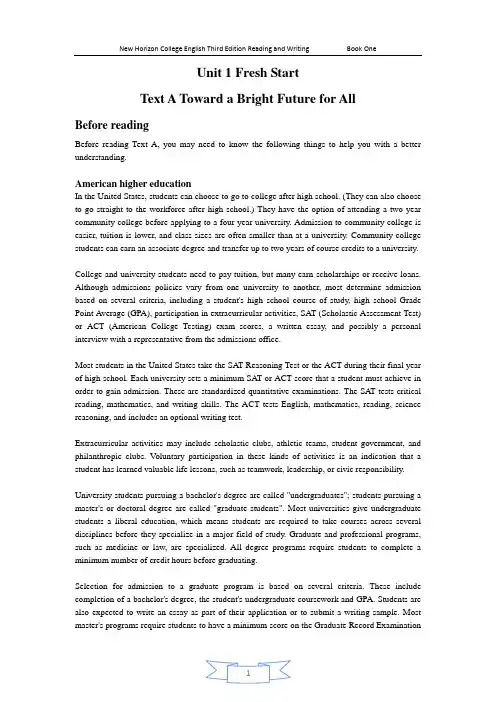
Unit 1 Fresh StartText A Toward a Bright Future for AllBefore readingBefore reading Text A, you may need to know the following things to help you with a better understanding.American higher educationIn the United States, students can choose to go to college after high school. (They can also choose to go straight to the workforce after high school.) They have the option of attending a two-year community college before applying to a four-year university. Admission to community college is easier, tuition is lower, and class sizes are often smaller than at a university. Community college students can earn an associate degree and transfer up to two years of course credits to a university.College and university students need to pay tuition, but many earn scholarships or receive loans. Although admissions policies vary from one university to another, most determine admission based on several criteria, including a student's high school course of study, high school Grade Point Average (GPA), participation in extracurricular activities, SAT (Scholastic Assessment Test) or ACT (American College Testing) exam scores, a written essay, and possibly a personal interview with a representative from the admissions office.Most students in the United States take the SAT Reasoning Test or the ACT during their final year of high school. Each university sets a minimum SAT or ACT score that a student must achieve in order to gain admission. These are standardized quantitative examinations. The SAT tests critical reading, mathematics, and writing skills. The ACT tests English, mathematics, reading, science reasoning, and includes an optional writing test.Extracurricular activities may include scholastic clubs, athletic teams, student government, and philanthropic clubs. V oluntary participation in these kinds of activities is an indication that a student has learned valuable life lessons, such as teamwork, leadership, or civic responsibility.University students pursuing a bachelor's degree are called "undergraduates"; students pursuing a master's or doctoral degree are called "graduate students". Most universities give undergraduate students a liberal education, which means students are required to take courses across several disciplines before they specialize in a major field of study. Graduate and professional programs, such as medicine or law, are specialized. All degree programs require students to complete a minimum number of credit hours before graduating.Selection for admission to a graduate program is based on several criteria. These include completion of a bachelor's degree, the student's undergraduate coursework and GPA. Students are also expected to write an essay as part of their application or to submit a writing sample. Most master's programs require students to have a minimum score on the Graduate Record Examination(GRE), which tests verbal reasoning, quantitative reasoning, critical thinking, and analytical writing skills.Students continue to take courses at the graduate level. A final thesis is required for most master's programs. Doctoral students take courses until they have earned enough credit hours to attempt their qualifying examinations. These are usually taken over several days and often include a written and oral component. After doctoral students pass their qualifying exams, they are advanced to candidacy and can begin writing their dissertation. Before the degree is given, the completed dissertation must be orally defended before the candidate's faculty committee.Vera WangVera Wang (王薇薇, 1949- ) is aChinese-American fashion designer. Shewas born and raised in New York City.While trained as a figure skater in highschool, she eventually earned a degree in arthistory from Sarah Lawrence College in1971. But a career in fashion was her dream.She worked as a senior fashion editorfor Vogue magazine for 15 years. In 1985,she left Vogue and joined Ralph Lauren as adesign director for two years. In 1990, she opened her own design salon in New York, and featured her trademark bridal gowns. Wang has made wedding gowns for many celebrities and public figures, such as Jennifer Lopez (珍妮弗•洛佩兹), Sharon Stone (莎朗•斯通) and Chelsea Clinton (切尔西•克林顿).Detailed study of the textPara.1. Good afternoon! As president of the university, I am proud to welcome you to this university. Your achievement is the triumph of years of hard work, both of your own and of your parents and teachers. Here at the university, we pledge to make your educational experience as rewarding as possible.下午好!作为校长,我非常自豪地欢迎你们来到这所大学。

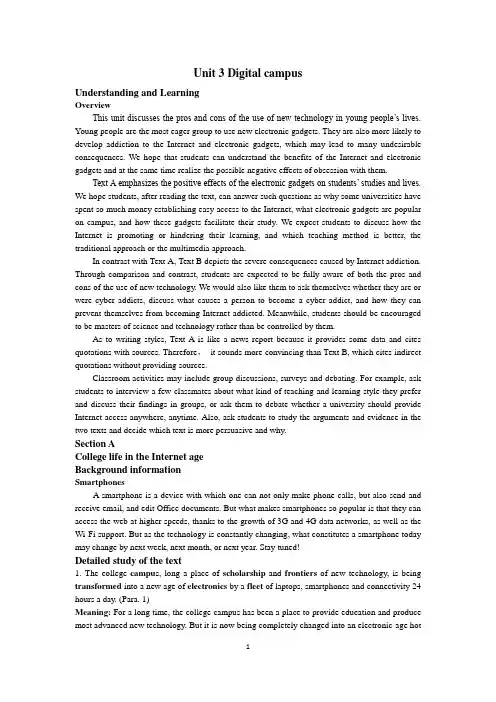
Unit 3 Digital campusUnderstanding and LearningOverviewThis unit discusses the pros and cons of the use of new technology in young people’s lives. Young people are the most eager group to use new electronic gadgets. They are also more likely to develop addiction to the Internet and electronic gadgets, which may lead to many undesirable consequences. We hope that students can understand the benefits of the Internet and electronic gadgets and at the same time realize the possible negative effects of obsession with them.Text A emphasizes the positive effects of the electronic gadgets on students’ studies and lives. We hope students, after reading the text, can answer such questions as why some universities have spent so much money establishing easy access to the Internet, what electronic gadgets are popular on campus, and how these gadgets facilitate their study. We expect students to discuss how the Internet is promoting or hindering their learning, and which teaching method is better, the traditional approach or the multimedia approach.In contrast with Text A, Text B depicts the severe consequences caused by Internet addiction. Through comparison and contrast, students are expected to be fully aware of both the pros and cons of the use of new technology. We would also like them to ask themselves whether they are or were cyber addicts, discuss what causes a person to become a cyber addict, and how they can prevent themselves from becoming Internet-addicted. Meanwhile, students should be encouraged to be masters of science and technology rather than be controlled by them.As to writing styles, Text A is like a news report because it provides some data and cites quotations with sources. Therefore,it sounds more convincing than Text B, which cites indirect quotations without providing sources.Classroom activities may include group discussions, surveys and debating. For example, ask students to interview a few classmates about what kind of teaching and learning style they prefer and discuss their findings in groups, or ask them to debate whether a university should provide Internet access anywhere, anytime. Also, ask students to study the arguments and evidence in the two texts and decide which text is more persuasive and why.Section ACollege life in the Internet ageBackground informationSmartphonesA smartphone is a device with which one can not only make phone calls, but also send and receive email, and edit Office documents. But what makes smartphones so popular is that they can access the web at higher speeds, thanks to the growth of 3G and 4G data networks, as well as the Wi-Fi support. But as the technology is constantly changing, what constitutes a smartphone today may change by next week, next month, or next year. Stay tuned!Detailed study of the text1. The college campu s, long a place of scholarship and frontiers of new technology, is being transformed into a new age of electronics by a fleet of laptops, smartphones and connectivity 24 hours a day. (Para. 1)Meaning: For a long time, the college campus has been a place to provide education and produce most advanced new technology. But it is now being completely changed into an electronic-age hotspot by the wide use of laptops, smartphones, and access to the Internet 24 hours a day.★campus: n. [C, U] the land and buildings of a university or college (大学或学院的) 校园All freshman students live on campus. When they are in their second year at college, they may live off campus. 所有大学一年级的学生都住在校园里。
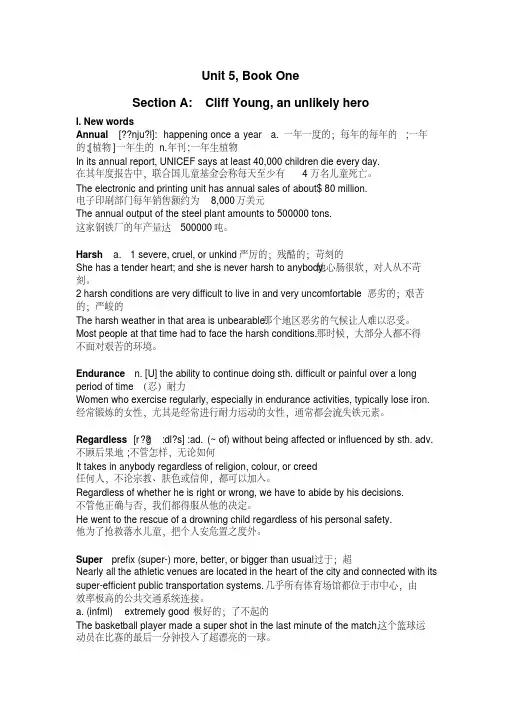
Unit 5, Book OneSection A: Cliff Young, an unlikely heroI. New wordsAnnual [??nju?l]: happening once a year a. 一年一度的;每年的每年的;一年的;[植物]一年生的n.年刊;一年生植物In its annual report, UNICEF says at least 40,000 children die every day.在其年度报告中,联合国儿童基金会称每天至少有4万名儿童死亡。
The electronic and printing unit has annual sales of about$ 80 million.电子印刷部门每年销售额约为8,000万美元The annual output of the steel plant amounts to 500000 tons.这家钢铁厂的年产量达500000吨。
Harsh a. 1 severe, cruel, or unkind 严厉的;残酷的;苛刻的她心肠很软,对人从不苛She has a tender heart; and she is never harsh to anybody.刻。
2 harsh conditions are very difficult to live in and very uncomfortable 恶劣的;艰苦的;严峻的The harsh weather in that area is unbearable. 那个地区恶劣的气候让人难以忍受。
Most people at that time had to face the harsh conditions. 那时候,大部分人都不得不面对艰苦的环境。
Endurance n. [U] the ability to continue doing sth. difficult or painful over a long period of time (忍)耐力Women who exercise regularly, especially in endurance activities, typically lose iron. 经常锻炼的女性,尤其是经常进行耐力运动的女性,通常都会流失铁元素。
Unit 1Fresh StartUnderstanding and LearningOverviewThe first unit of the first book of our series meets students who have just entered college or university and are beginning a new phase in their lives. We hope that students will be able to talk about their expectations of their college experience, and they will be aware of the expectations their parents and their educators have of them.Text A is a university president’s welcome speech, in which the president gives valuable guidance to and expresses expectations of freshman students.Text B is a letter written by a father to his child who is about to start college, in which the father expresses his expectations of the child. We hope that the two texts will stimulate students to share their own expectations regarding their college experience; and we also hope the two texts will help students look from a new perspective at the expectations their educators and their parents have of themText A shows characteristics of a speech. Pronouns I, we and you are more frequently used than in other kinds of writing because the speaker is addressing the audience directly, hoping to motivate the audience and to gain their support and understanding. In a speech, the speaker can employ a variety of figures of speech to make his speech vivid and powerful, such as simile, metaphor, contrast, parallelism(排比), and repetition. A very common figure of speech is parallelism. In parallelism, coordinate ideas are arranged in words, phrases, sentences, and paragraphs to emphasize and point out relations. In Text A, for example, the president uses many sentences of parallel structure. This makes his speech powerful, persuasive, and thought-provoking. It can even produce humorous effect as in the example: “You may have cried tears of joy to be finally finished with high school, and your parents may have cried tears of joy to be finally with doing your laundry!”The most obvious feature of Text B is that it contains many imperative sentences, and these sentences tend to be brief. An imperative sentence advises, instructs, requests, or commands. It begins with a verb; the implied subject is you.In Text B, a father makes use of imperative sentences to give advice and instructions to his child who has just left home for college. For example: “Don’t be bound by what other people think.”“Pick friends who are genuine and sincere.”“Become the great thinker you were born to be.”In class the teacher can make the students compare the writing styles of Text A and Text B. Class activities may include pair work, group discussions, and mini-surveys about students’high school experience, their families and friends, and their expectations of college life.Section AToward a brighter future for allBackground information1. American higher educationIn the United States, students can choose to go to college after high school. (They can also choose to go straight to the workforce after high school.) They have the option of attending a two-year community college before applying to a four-year university. Admission to communitycollege is easier, tuition is lower, and class sizes are often smaller than at a university. Community college students can earn an associate agree and transfer up to two years of course credits to a university.College and university students need to pay tuition, but many earn scholarships or receive loans. Although admissions policies vary from one university to another, most determine admission based on several criteria, including a student’s high school course of study, high school Grade Point Average (GPA), participation in extracurricular activities, SAT(Scholastic Assessment Test) or ACT (American College Testing) exam scores, a written essay, and possibly a personal interview with a representative from the admissions office.Most students in the United States take the SAT Reasoning Test or the ACT during their final year of high school. Each university sets a minimum SAT or ACT score that a student must achieve in order to gain admission. These are standardized quantitative examinations. The SAT tests critical reading, mathematics, and writing skills, The ACT tests English, mathematics, reading, science reasoning, and includes an optional writing test.Extracurricular activities may include scholastic clubs, athletic teams, student government, and philanthropic clubs. V oluntary participation in these kinds of activities is an indication that a student has learned valuable life lessons, such as teamwork, leadership, or civic responsibility.University students pursuing a bachelor’s degree are called “undergraduates”; students pursuing a master’s or doctoral degree are called “graduate students”. Most universities give under graduate students a liberal education, which means students are required to take courses across several disciplines before they specialize in a major field of study. Graduate and professional programs, such as medicine or law, are specialized. All degree programs require students to complete a minimum number of credit hours before graduating.Selection for admission to a graduate program is based on several criteria. These include completion of a bachelor’s degree, the student’s undergraduate coursework and GPA. Students are also expected to write an essay as part of their application or to submit a writing sample. Most master’s programs require students to have a minimum score on the Graduate Record Examination (GRE), which tests verbal reasoning, quantitative reasoning, critical thinking, and analytical writing skills.Students continue to take course at the graduate level. A final thesis is required for most master’s programs. Doctoral students take course until they have earned enough credit hours to attempt their qualifying examinations. These are usually taken over several days and often include a written and oral component. After doctoral students pass their qualifying exams, they are advanced to candidacy and can begin writing their dissertation. Before the degree is given, the completed dissertation must be orally defended before the candidate’s faculty committee.2. Vera WangVera Wang is a Chinese-American fashion designer. She was born and raised in New York City. While trained as a figure skater in high school, she eventually earned a degree in art history from Sarah Lawrence College in 1971. But a career in fashion was her dream. She worked as a senior fashion editor for Vogue magazine for 15 years. In 1985, she left vogue and joined Ralph Lauren as a design director for two years. In 1990, she opened her own design salon in New York, and featured her trademark bridal gowns. Wang has made wedding gowns for many celebrities and public figures, such as Jennifer Lopez (詹尼佛·洛佩兹), Sharon Stone (莎朗·斯通) and Chelsea Clinton (切尔西·克林顿).。
Unit6 Book1Section B: Earn As You Learn?I. Teaching Objectives:1. Key words: soar; tremendous; relevant; claim; endure; illustrate; exhaust; relieve; convince; ensure; advanced2. Key phrases: in spite of; be envious of; be in the/a minority; a matter of doing sth.; relieve sb. of sth. ; look back.; as for; catch/get/have a glimpse of3. Reading Skill: Understanding signal wordsII.Teaching Procedures:1. Warming-upDiscuss in group some critical questions concerning the relationship between work and study.2. Text learning1) Reading skills2) New words3) Practical phrases.4) Text comprehension.5) Structure analysis of the text3. Assignment.III. Suggested Class Activities1)What part time jobs are suitable for undergraduates?2)What are the advantages of studying full-time, if compared with working while studying?3)How can students strike a balance between work and study?(Tips: good time management; modest working hours; efficiency in work and study; good health...)4)How do you feel about the students who work to pay their own tuition?IV. Assignments1. Finding out and underline the signal words in Paragraph 1 and 7 in text B.2. Complete the excises.Text learningI. Reading skills: Understanding signal wordsStep 1. Why signal words are needed?Signal words can be a valuable aid in predicting what is coming next; they can also help to identify the pattern the writer is using to get the point(s) across. Signal words may be found anywhere in a paragraph to show relations between sentence parts, between sentences, or even between paragraphs.Step 2. The types of signal words?a.Words that signal additional informationb.Words that signals an example or explanationc.Words that signal a summary or conclusiond.Words that signal a change of thoughte.Words that signal comparison or contrastf.Words that signal a sequence or time orderg.Words that signal cause, condition, or resulth.Words that signal emphasisII. New words1. soar vi.a. Increase to a high level (amount, level, value or volume)The prices of houses have been soaring in recent years. 房价近几年一直在飞涨。
新视野⼤学英语第三版读写教程第⼀册Unit2教案----Unit 2, Book OneSection A: Loving parents, loving children1. Teaching Objectives:To talk about the love between the parents and childrenTo understand the love between the mother and the daughter in the textTo apply the phrases and patternsTo write an essay creatively based on the understanding of the text2.Time Allotment:Section A (3 periods):stnd period: Pre-reading activities ( theme-related questions for warming up;) ---21While-reading activities (cultural notes; useful words and expressions;difficult sentences)rd3 period: While-reading activities (text structure; main ideas)Section B(1period):th4periods: Practice of the reading skill (reading for the key idea in a sentence);T checks on Ss'home reading by asking questions based on the passage.T explains some difficult sentences3.Teaching Procedures:Pre-reading ActivitiesStep 1. GreetingsGreet the whole class warmly.Step 2. Lead-in and preparation for readingLet them have a surveySurvey: How close are you and your parents?Check ( √) the statements which are true for you.I have been missing my parents a lot since I left for college.I often chat with my parents.I like sharing my joys and sorrows with my parents. birthdays.I always remember my parents'I know about my parents hobbies.'My parents allow me to make my own decisions.Ask a question: To what extent are you close to your parents? be like friends;never keep secret from them;ask them for advice;give me directions about life?------Step 3. Fast readingAsk the Students to read the passage as quickly as they can and then answer the questions onthe screen. Let them get the main idea of each paragraph and make clear about the text structure.Text structure: ( structured writing ) The passage can be divided into 3 parts.Part1 (para.1-4) Opening part of the welcome speechGeneral situation & my responses.Part 2 (para.5-12)The mess left inmy daughter s'bathroom and my responses.Part 3 (Para.13-22) Concluding part: The changes of my attitude.Purpose: Improve the students'reading and writing ability and understand the general idea ofeach paragraph.Method: Read the text individually and talk in groups; Use task-based language teachingmethod, reading approach, communicative approach and total physical response method.Step 4. Preparation for details of the text on the screenStudents are requiredto look at the Words and Phrases on the screen and give a briefpresentation in class.Words and Phrases:Purpose: Train the Students' ability of understandingusing foreign language.Method:Talk in groups, Use task-based language teaching method,communicativeapproach and total physical response method.1.(Para.1) make it.成功;准时到达With blood pouring from his leg, he made it to a nearby house.他腿上流着⾎,⽀撑着⾛到附近的⼀所房⼦。
第教学周 /第节(第次课)第1页To talk about the sporting spirit教学目的To further understand the textTeachingTo apply the phrases and patternsObjectives:To master the paragraph writing skill1.Know how to analyze and use writing devices教学重点与难2. Drills of important phrases in the text点 3. Know how to analyze the narrative style of the writer and the developmentof the process about the content, and use these devices1.lecture and explanation教学方法与手 2. discussion and retelling段 3. PowerPoint4. deduction教学的基本内容Unit 5 Section A: Cliff Young, an unlikely heroTeaching Procedures:Pre-reading ActivitiesStep 1. GreetingsGreet the whole class warmly.Step 2. Lead-in and preparation for readingLet them talk to each other about the following questions:1.What sports do you like doing?2.How much time do you spend on sports every day?3.Do you think playing sports is important to students? Why?Step 3. Fast readingAsk the Students to read the passage as quickly as they can and then answer the questions on the screen. Let them get the main idea of each paragraph and make clear about the text structure.Text structure: ( structured writing ) The passage can be divided into 3 parts.Part1 (para.1-10) Cliff Young took part in the Australian marathon in 1983 and finally won it.Part 2 (para.11-13)Cliff Young’ s life after the race of 1983Part 3 (Para.14) Cliff Young sets a good example for other people.Purpose: Improve the students’ re a nddingwriting ability and und erstand the general idea of each paragraph.教学的基本内容Method: Read the text individually and talk in groups; Use task-based language teaching method, reading approach, communicative approach and total physical response method.Step 4. Preparation for details of the text on the screenStudents are required to look at the Words and Phrases on the screen and give a brief presentation in class.Words and Phrases:Purpose: Train the Students’ability of understanding and using foreign language.Method: Talk in groups, Use task-based language teaching method, communicative approach and total physical response method.1. (Para.1) up to 达到;至多The Olympic Stadium will hold up to 80,000 spectators.奥林匹克体育场将可容纳多达8 万观众。
Unit 1 Book OneSection A: Toward a brighter future for all Teaching Objectives:To know the meaning and usage of some important words, phrases and patterns To study Passage A and understand the main idea of the textTo understand the structure of the text and the devices for developing itTo talk about college educationTeaching Procedures:Pre-reading ActivitiesStep 1. GreetingsGreet the whole class warmly.Step 2. Lead-in and preparation for readingLet them talk to each other about the following questions:1. What is the ideal university like in your eyes?2. What are your expectations of your college life?3. What advice did your parents give you before you left for college?Step 3. Fast readingAsk the Students to read the passage as quickly as they can and then answer the questions on the screen. Let them get the main idea of each paragraph and make clear about the text structure.Text structure: ( structured writing ) The passage can be divided into 3 parts.Part1 (para.1-3) Opening part of the welcome speechPart 2 (para.4-7) Making the best of what you have.Challenging yourself.Facing new experiences.Opportunities and responsibilities.Part 3 (Para.8) Concluding remarks of the welcome speech.Purpose: Improve the students’ reading and writing ability and understand the general idea of each paragraph.Method: Read the text individually and talk in groups; Use task-based language teaching method, reading approach, communicative approach and total physicalresponse method.Step 4. Preparation for details of the text on the screenStudents are required to look at the Words and Phrases on the screen and give a brief presentation in class.Words and Phrases:Purpose: Train the Students’ ability of unde rstanding and using foreign language.Method:Talk in groups, Use task-based language teaching method, communicative approach and total physical response method.1. (Para.1)pledge to do sth. 作保证,承诺China and the United states pledge to boost cooperation and exchange to ensure a better future for China-US ties.中美政府承诺将加强合作与交流以确保两国关系的未来更加美好。
2. (Para.2) remind sb. of sb. /sth.1) make sb. remember sb. that they know or sth. that happened in the past. 使某人想起某人某事The song always reminds me of our holiday in Mexico. 那首歌总让我想起我们在墨西哥的那次假期。
2)be very similar to sb. or sth. else 是某人想起(相似的)人或事Nancy was tall and slim, and reminded me of my cousin Sarah.3. (Para.2)reminder: n. [C] sth. that makes you notice, remember, or think about sth. 起提醒作用的东西The cold served as a reminder that winter wasn’t quite finished. 寒冷的天气提醒人们冬天还没有过去。
4. (Para.3)attain:vt.(fml.)succeed in achieving sth. after trying for a long time. 得到;获得;赢得Not all athletes attain this standard of physical fitness. 并非所有的运动员都能达到这种身体素质水平。
5. (Para.3) foundation:n. [ C] the most basic part of sth. from which the rest of it develops 基础The course gives students a solid foundation in English writing skills. 这门课为学生的英语写作能力打下了坚实的基础。
6. (Para.4) facility:n. (~ies) [pl.] rooms, equipment, or services that are provided for a particular purpose (为某种目的而提供的)设施,设备The hotel has an indoor swimming pool and other leisure facilities. 这家宾馆有室内游泳池和其他休闲设施。
7. (Para.4) fascinating:a. making you very interested attracted 吸引人的;迷人的;使人神魂颠倒的He is such a great writer that his stories are always fascinating.他是个了不起的作家,他写的故事总是引人入胜。
8. (Para.4) make the most of充分利用This article introduces 7 tips for making the most of your iPhone5S.这篇文章向你介绍iPhone5S手机的7个使用小窍门。
9. (Para.4)reap the benefits 受益,得享好处Keep on reading extensively, and you will reap the benefits sooner or later.继续广泛阅读,你会受益的。
10. (Para.5)feel overwhelmed by. 不知所措Nowadays, many young people feel overwhelmed by the fierce competition in the job market.现如今,激烈的竞争让许多年轻人不知所措。
11. (Para.5) assume: vt. Think that sth. is true, although you do not have definite proof 假定;假设;认为I assume that every college student has access to the Internet.我以为每个大学生都可以使用互联网。
12. (Para.5)stand a chance of有机会,有希望Animals stand little chance of survival under such extreme weather.在这种极端天气下动物很难存活。
13. (Para.5) unsuspected: a. existing without your knowledge 未知的;未被想到的14. take pleasure in doing sth.乐于做某事He always takes great pleasure in lending a helping hand to people around him.他总是乐于向周围的人伸出援助之手。
15. open the door to sth.打开方便之门These useful suggestions open the door to better communication with your parents.这些实用的建议为你更好地与父母交流敞开方便之门。
Step 5: While-reading ActivitiesLanguage Points:1. Your achievement is the triumph of years of hard work, both of your own and of your parents and teachers. (Para. 1)Meaning: Your entering this university is an important success. This success is due to many years of your hard work, and many years of your parents’and teachers’ hard work.2. In welcoming you to the university, I am reminded of my own high school graduation and the photograph my mom took of my dad and me. (Para. 2) Meaning: When I am welcoming you to this university, something I remember is my own high school graduation and the photo my mom took of my dad and me.3. But know this:The future is built on a strong foundation of the past. ( Para. 3) Meaning: But you should know that your future success can only be attained when it is built on a solid past.4. For you, these next four years will be a time unlike any other. (Para.4) Meaning: For you, the next four years in university will be different from any other period of time in your life.5. You may feel overwhelmed by the wealth of courses available to you. (Para. 5) Meaning: When facing the large number of courses that you can take at college, you may not know how to choose.6. You will not be able to experience them all, but sample them widely! (Para. 5) Meaning: You will not be able to take all the courses, but try as many different courses as possible to see what they are like.7. So, with a glow in your eye and a song in your heart, step forward to meet these new experiences! (Para. 6)Meaning: Therefore, with the excitement and enthusiasm that I know you must have in your heart, I encourage you to go forward from here and face this new part of your life!8. A wise man said: “Education is simply the soul of a society as it passes from one generation to another.” (Para. 7)Meaning: A wise man said that education is truly the spirit and heart of a society because it passes from generation to generation.9. Now it is your turn. (Para. 7)Meaning: Now it is time for you to acquire knowledge and pass it on.10. We take great pleasure in opening the door to this great step in your journey. We take delight in the many opportunities which you will find, and in the responsibilities that you will carry as citizens of your communities, your country, and the world. (Para.8 )Meaning: We are very happy to open the door to this next great step in your journey. We are delighted that you will find many different opportunities and many responsibilities, which you will shoulder as citizens of your communities, your country, and the world.Step 6: Typical patterns:Purpose: Further understand the text (Train further reading ability)to find out some difficult sentences and details of the text.Method:Read the text together; Use task-based language teaching method, reading approach, communicative approach, grammar-translation approach and total physical response method.Typical patterns:1 . As president of the university, I am proud to welcome you to this university.作为校长,我非常自豪地欢迎你们来到这所大学。